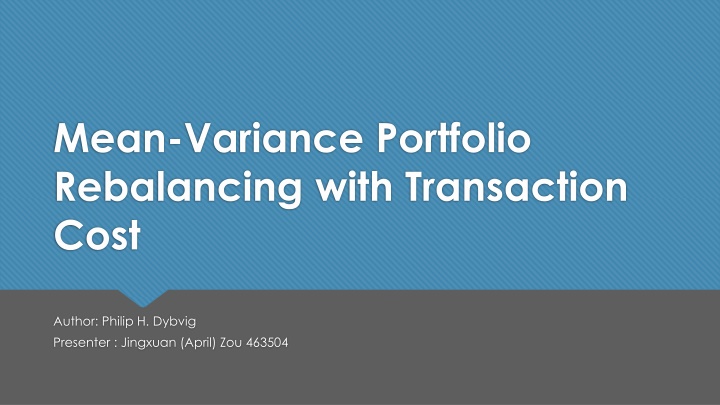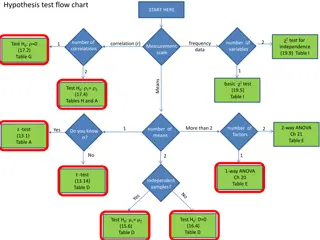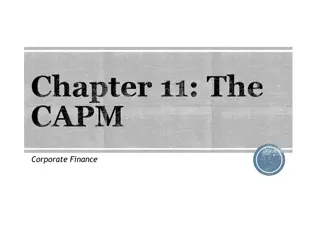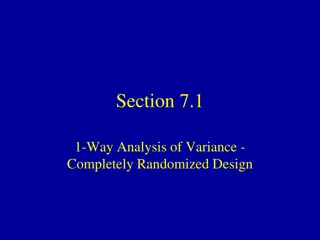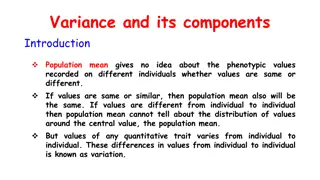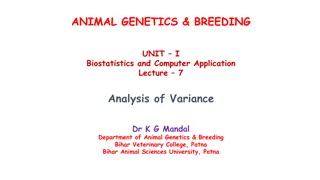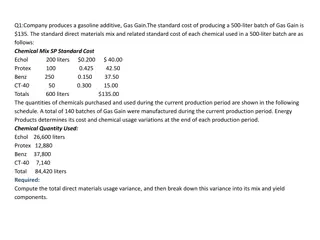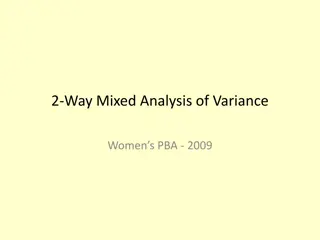Mean-Variance Portfolio Rebalancing with Transaction Cost Overview
This presentation delves into the dynamics of portfolio rebalancing with transaction costs, examining key concepts like numerical analysis for two risky assets and theoretical analysis for single risky assets. Previous research in the field and strategies for managing variable costs are also discussed.
Download Presentation

Please find below an Image/Link to download the presentation.
The content on the website is provided AS IS for your information and personal use only. It may not be sold, licensed, or shared on other websites without obtaining consent from the author.If you encounter any issues during the download, it is possible that the publisher has removed the file from their server.
You are allowed to download the files provided on this website for personal or commercial use, subject to the condition that they are used lawfully. All files are the property of their respective owners.
The content on the website is provided AS IS for your information and personal use only. It may not be sold, licensed, or shared on other websites without obtaining consent from the author.
E N D
Presentation Transcript
Mean-Variance Portfolio Rebalancing with Transaction Cost Author: Philip H. Dybvig Presenter : Jingxuan (April) Zou 463504
Agenda Introduction Numerical Analysis for Two Risky Asset Theoretical Analysis for Single Risky Asset Conclusion & Discussion
Previous Research Portfolio rebalancing with transaction costs problem Portfolio with two assets: continuous-time model + free boundary problem Portfolio with more assets: multi-asset continuous-time model + extreme case Mean-variance analysis framework Markowitz[1952,1959]: basic formulation & quadratic programming tools Tobin[1958]: macroeconomic implications Jacob[1974]: number constraint; Brennan[1975]: fixed cost; Mao[1970,1971]: adding securities without modeling the costs
Non-trading region A general model using matrix algebra accommodates features following: Multiple risky assets Trading stocks individually/by bundle Trading futures and swaps A set of portfolio positions from which there is no trade that would justify the cost of trading Parallelogram: individual stocks + cash settlement Rectangle/Square uncorrelated returns The non-trading region of one risky asset depends on the positions in the other securities due to correlations Different boundaries for purchasing and selling because of the wedge
Numerical Analysis for Two Risky Asset
Variable Costs Security-specific variable costs Two correlated risky assets ?:??????? ??? ?????? ???? ?:??????? ??? ???????? ????? Positive correlation: substitutes Over-weighting in one security while under- weighting in the other is less likely to trade Over/under-weighting in one security while over/under-weighting in the other is more serious
Futures Overlay Futures are used to correct minor deviations (< 3%) of the ideal allocation Synthetic equity : futures and bonds Correlation with underlying equity 1 Much less expensive to trade
Futures Overlay Higher return from the underlying equities than synthetic equity Active management Cost of rolling the futures Tax-timing advantages to equity Optimal strategy: asymmetric Sell futures to correct for overexposure Buy underlying equities to correct for underexposure
Bundles Trading Cost-effective More complex trading pattern Simultaneous buys and sells of different individual securities to compensate for imbalances caused by trading the bundle
Overall Fixed Costs Same ideal portfolio Utility of not trading VS Utility of trading to the ideal point with the fixed cost Optimal to trade when outside the indifference curve (ellipse) and not trading inside
Security-Specific Fixed Costs Comes from a due diligence requirement to monitor or document any security A complex combinatorial problem: each possible set gives different overall nonconcave objective functions More general without assuming the starting position is in cash
Theoretical Analysis for Single Risky Asset
Problem 1: Proportional costs Choose purchase P and sales S of the risky asset to maximize the utility function Expected return Disutility of taking on variance Penalty for tracking error Transaction costs
Solution: Proportional costs ? ?0 ?:? = ? = 0 ?0< ? ? = ? ?0,? = 0 ?0> ?:? = 0,? = ?0 ?
Problem 2: Fixed cost Choose a quantity of the risky asset to maximize the utility function
Solution: Fixed cost ?0< ??:? = ? ?0,? = 0 ?:? = 0,? = ?0 ? ?0> ?
Conclusion Single-period rebalancing problem in a mean-variance framework Variable cost models It is optimal to trade only to the boundary of the non-trading region Costly trading Synthetic equity strategy Asymmetric futures overlay strategy Bundle trading Fixed cost models Any trade moves to inside the non- trading region if it is optimal to trade Overall fixed cost Security-specific fixed cost
Discussion Current analysis It analyzes a one-period mean-variance portfolio rebalancing problem with proportional transactions costs and obtains instructive explicit solutions. It provides a simplified and easy- understanding analysis framework (non- trading region) to analyze the similar problems and understand economics behind that in the real world. It can be extended to the multi- period/continuous-time model It does not consider market equilibrium and can be developed to consider the quadratic transaction costs Rebalancing from any starting portfolio Variable costs Traditional literature Purchase of a portfolio from scratch Fixed costs
Questions? Thanks!
